(PDF) Anxiety disorders in older adults
Added on 2021-06-17
34 Pages9370 Words58 Views
CHAPTER TWO 1Difference in Non-Clinical Anxiety Levels between Young and Older Adults and inRespect to Depression, Cognitive Functions and Demographic ParametersABSTRACTINTRODUCTION: METHODS: RESULTS: CONCLUSION: Keywords: Non-Clinical Anxiety, Depression, Subjective memory function, and Objective Cognitive Function, Demographic Parameters, Younger adults, Older adults.

CHAPTER TWO 2ABSTRACTRelationship between anxiety levels and speed of information processing in young and older adults has hardly been researched on, in relation to the plethora of brain functions that encompass attention and other cognitive functions. This research taps into this gap, evaluating the relationship between subclinical anxiety, cognitive functions and demographic factors. Methods used in data collection include Progressive Retrogressive Memory Questionnaire (PRMQ), Beck Anxiety Inventory (BAI), Beck Depression Inventory (BDI), State and Trait Anxiety Inventory (STAI), Trait and Anxiety Inventory (TAI) and Montreal Cognitive Assessment (MoCA). The results obtained from these methods were closely related, confirming their reliability.Older group was found to be less susceptible to different subclinical anxiety levels and its effects than the younger group; inhibitorycognitive control is better managed by the older group than the younger group. Demographic factors do not cause much non-clinical anxietyas is seen in the results section.
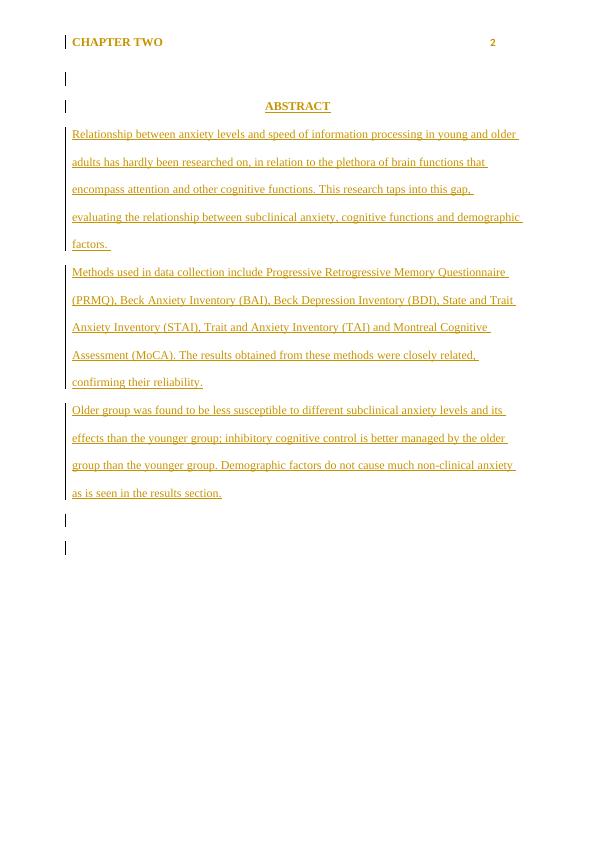
CHAPTER TWO 3INTRODUCTION This study aims at examining the difference in subclinical anxiety levels between young andolder adults in relation to depression, subjective memory function, objective cognitivefunction and demographic factors, that isare, age, gender, years of education, handedness,eyesightwhich are not extensively iterated in previous studies is also examined.. etc. wealso need to say, why it is important to look at all those terms and see the correlation betweenthem, before start looking at attention and information processing speed deeply. Does thatprovide you a sign or and evidence re. non-clinical anxiety influences or something?Theprimary objective of this research is to evaluate the existing association between the speed ofinformation processing and non-clinical anxiety levels, among older and younger adults, inrelation to plethora of brain functions that encompass attention. These functions are generallyrelated to visual attention, selective attention, inhibitory cognitive control, reaction time(RT)and intra-individual reactive time (IIRT). The research also aims to determine the relationship between the aforementioned non-clinicalanxiety levels and cognitive function, both subjective and objective, quality of sleep anddemographics such as age, gender, handedness, education levels or attainment and vision ofthe participants.Depression and anxiety disorders are linked with abnormal cognitive control in the form of anattentional bias towards negative information and reduced inhibitory control (Cisler &Koster, 2010). Even though there is a high rate for comorbidity of the anxiety disorders anddepression, above 75%, they have various underlying neural correlates. The high comorbidityimplies commonality in etiology (Peckham, McHugh & Otto, 2010). The dorsal anteriorcingulate cortex is involved in inhibitory cognitive control. It detects conflict between
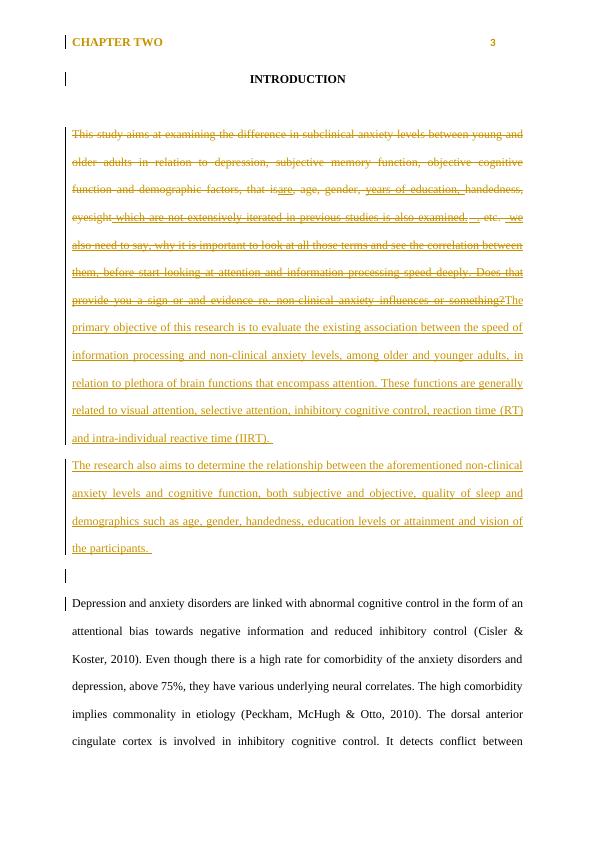
CHAPTER TWO 4competing neural representations in the perceptuo-motor system and gives a signal to thedorso-lateral prefrontal cortex to help in adjusting the system to a regulated level. Depression and clinical anxiety disorders are severe diseases that affect lives of people, bothmentally and physically[ CITATION Ame98 \l 1033 ]. Some symptoms appear in milder formseven among individuals considered as psychologically healthy (Park et al., 2010). At theclinical levels, anxiety and depression severely affect the inhibitory cognitive control[ CITATION Mic07 \l 1033 ]. The clinical symptoms show existence of some relationshipwithThere is considerable decrease in activity within anterior cortical control structureswhich is responsible for most cognitive functions including attention allocation, decisionmaking, impulse control etc. . For example, levels of clinical anxiety happen to inverselycorrelate to dorsolateral prefrontal cortex (DIPFC) activity in a conflict task [ CITATION Rom13\l 1033 ]. There exists evidence of an inverse relationship between depression andresting-state activity of the anterior cingulate cortex (ACC)[ CITATION Rob07 \l 1033 ]. Ahighly depressed individual has a hyperactive performance in the ACC, and at certain levelsof anxiety and depression, it goes into a resting state, bringing a halt to important cognitivefunctions like attention allocation[ CITATION Aar88 \l 1033 ].Moreover, as it is evidenced thatJjust like in clinical anxiety and depression, increased levels of subclinical anxiety anddepression symptoms occur together pointing to the likelihood of the same cause(Pizzagalli et al., 2006). Taking this approach ends up in major theoretical challenges.This is why most researchers treat the two as one, since they both point to the sameetiologies. in the interpretation of the finding that if anxiety and depression are related thoughseparate dysfunctions, then it means that their frequent co-occurrence results in considerablemuddle. Studies done by various authors[ CITATION Sad09 \l 1033 ] and Anxiety AndDepression Association Of America (ADAA) show that anxiety and depression couldhave the same or different causes or etiologies [ CITATION Ame98 \l 1033 ], thus, it is

CHAPTER TWO 5acceptable to test the two separately and compare results thereafter. Nonetheless, veryfew studies have focused on determining the difference in anxiety level especiallysubclinical levels between young and older adults. Coming up with a more conclusivedistinction could help in developing proper interventions aimed at minimizing the negativeaffective states of anxiety and depression.We need to understand the difference betweenanxiety and depression terms, and see how the levels of anxiety could lead to depression. Wealso need to clarify the big overlap that exists between depression and anxiety as most studiesnormally treat them as one disorder and a whole clinical illness. Coming up with a moreconclusive distinction could help in developing proper interventions aimed at minimizing thenegative affective states of anxiety and depression.Anxiety and depression levels have been known to lower the cognitive performance ofpeople across all the age groups [ CITATION End01 \l 1033 ]. These two emotions havecomplex pathophysiology with many stimuli. Anatomically, emotions are integrated bythe limbic system. Well demonstrated by papiz circuit, cognition is a higher functionperformed by the prefrontal cortex and involves formation of new neurons andconnections. Emotions and cognition share pathways depending on stimuli. Anxiety anddepression load the brain and cognition requires brain alertness. When the two areactive simultaneously, they interfere with C1 neurons and divert attention making thebrain less receptive and less effective in information integration [ CITATION Sha11 \l1033 ]. There is evidence of significant decline in cognitive abilities among older adultsconsidered to have anxiety disorders which result in cognitive impairment (Price andMohlman,2007). Apart from clinical experiments [ CITATION Wil98 \l 1033 ], subclinicalanxiety levels have not been seriously researched on in relation to depression andcognitive impairment in a population-based sample across all age groups. Non-clinical
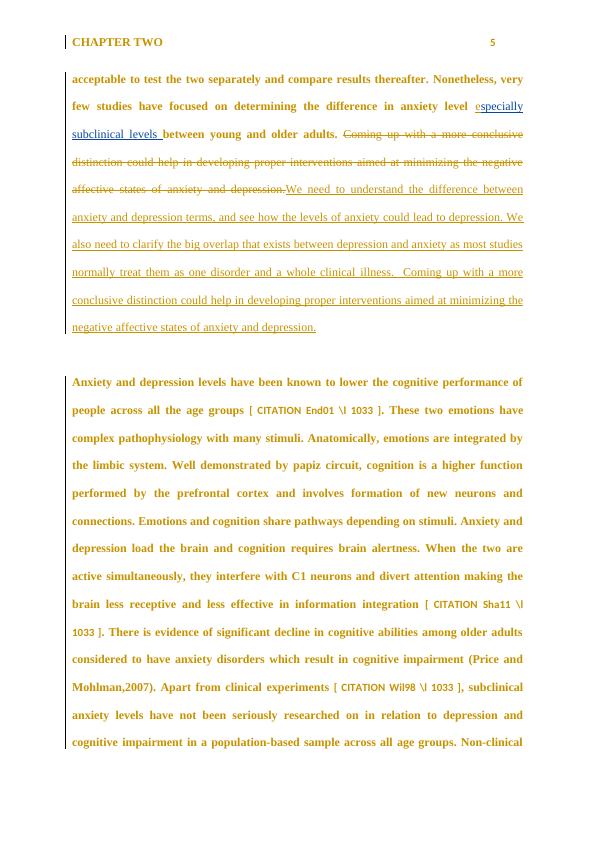
CHAPTER TWO 6anxiety affects both subjective and objective cognitive and memory processing ability ofany individual, though no extensive research has been done on effects of anxiety onattention and information processing speed.Goldberg et al., (2003) compared the effect of anxiety and depression on cognitivefunction of older and younger people and found that the cognitive ability of theyoungerolder group is lowered in relation to thought process, perception and generalproblem solving, more than that of the olderyounger group. However, Unterrainer et al.,(2018) differ with this observation based on the evidence from their study, thatsubclinical low anxiety levels and cognitive function of people are not related regardlessof age. The associations they observed in clinical groups differed with ones inpopulation-based samples. Higher ratings of anxiety were associated with lowerplanning performance independent of age. When they directly compared predictivevalues of depression and anxiety on cognitive ability, significance was only attained byanxiety while depression did not. The evidence from the two studies, Mattay et al.,(2003) and Unterrainer et al., (2018) do not adequately explain the explain the differencein effects of subclinical anxiety levels on cognitive function of individuals. Translationalthreats of arbitrary shock paradigm and anxiety levels that cause them is examined in thisstudy, including the amount of emotional response caused by the different levels of anxiety.This research explored this difference to help in better understanding of how differentlevels of anxiety impair cognition and also help improve measures in place to treatpatients with cognitive problems caused by non-clinical anxiety and depression. Youngand old people have significant differences in how the anxiety levels affect theircognitive abilities. Old people are less susceptible to different anxiety levels than youngpeople as will be seen in results section, which is in concurrence with previous studies
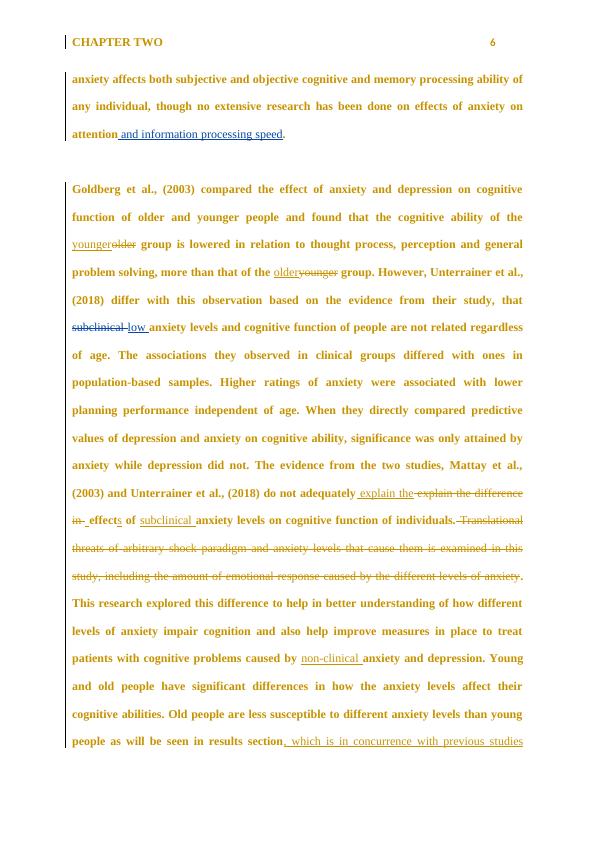
CHAPTER TWO 7[ CITATION USA13 \l 1033 ]. This is mostly because old people are more settled and do notworry about life and all its troubles. They are more interested in living in peace andintegrity. Subjective and objective cognitive functions are key elements in this studysince they determine how anxiety levels influence cognitive functions of both old andyoung groups. Although anxiety has been investigated in ageing, young vs old, it has only been onclinical levels or as a part of depression. Similarly, anxiety studies on ageing in relation todemographic factors has only been on a clinical scale. This study works on thesubclinical anxiety level.Most of the studies on effect of anxiety and depression on cognition have been on therelation to anxiety in general but there is a recognized investigation that has mainlytargeted the adults [ CITATION DiM00 \l 1033 ]. A number of studies on anxiety andcognition have targeted individuals who have mild cognitive impairment (MCI) anddementia, others focusing on formal anxiety disorders (Tales, & Basoudan, 2016). Non-clinical anxiety can affect elements of information processing than the ones that wereearlier recognized (Tales & Basoudan, 2016). For a very long time most of the studies relating anxiety and age have focused onsubclinical level in the older adults. Few studies have focused on subclinical anxiety amongthe youthyoung and older adults. Other studies have focused on effects of depressivesymptoms on cognition in the elderly [ CITATION Sin12 \l 1033 ] and looked at anxiety as apart or one withod depression symptoms. Though anxiety and depression has beenassociated with negative effect on cognition function, the correlation to the subclinicalanxiety level in the youth and older adults has not been exploredsubclinical anxiety hasn’tbeen studied separately from depression (Balash et al., 2013). It is against this background
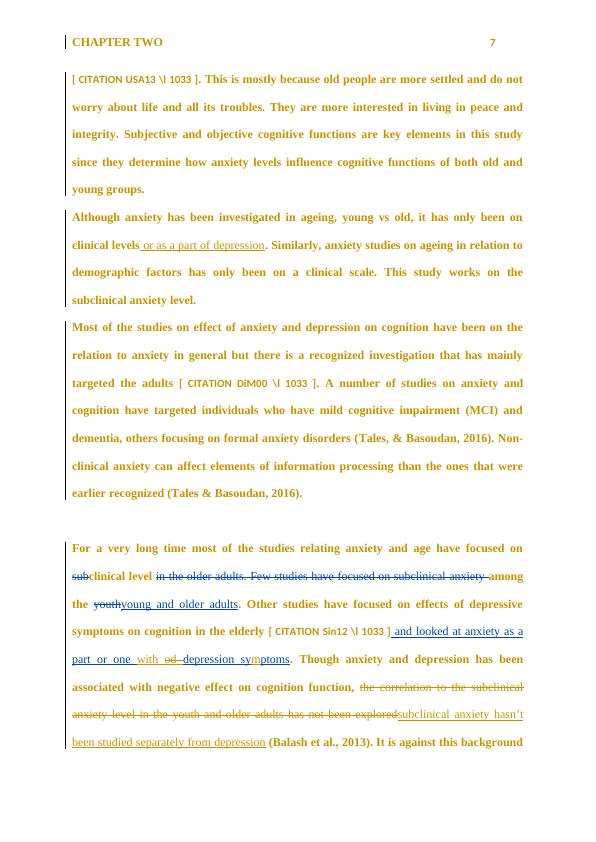
CHAPTER TWO 8that the study examines the difference in subclinical anxiety level between young andolder adults and their links to depression, demographic parameters and its effects oncognition. This study will also allow us to understand the differences between young and oldin terms of anxiety very well,in relation to many factors before looking deeply on attentionand information processing speed.The aim of this research is to examine the non-clinical anxiety, and its effects on individualsand on different degrees. METHODS This section briefly describes the methods used to conduct the investigation, includingparticipants, measuring instruments, and other details of how the research wasconducted. Ethical ConsiderationsThis study was conducted with the guidance and approval of the Research EthicsCommittee at the University Department of Psychology, which mandates informedconsent of all participants, along with their rights to withdraw from the study at anytime. The informed consent form was signed by all participants. All data collected inthis study was blinded to participant identity and stored under password protection onthe researcher’s computer. All the data is confidential and only accessible to responsibleauthorities. All data collected was used for empirical research, and not for any medicalpurpose.
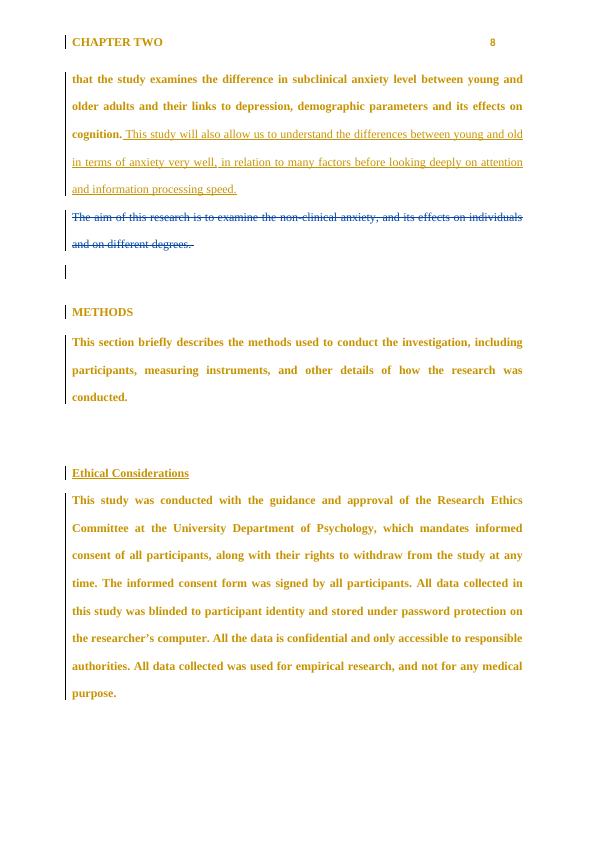
End of preview
Want to access all the pages? Upload your documents or become a member.
Related Documents
Effects of Anxiety on Different Aspects of Information Processinglg...
|34
|10399
|104
Difference in Non-Clinical Anxiety Levels between Young and Older Adults and in Respect to Depression, Cognitive Functions and Demographic Parameterslg...
|34
|10472
|446
Cognitive Inhibition Theories and Neuropsychological Measures: A Study on Younger and Older Adultslg...
|29
|8251
|308
Visual Search and Information Processing Speedlg...
|46
|13333
|304
Anxiety influence Information Processing Speed Assignmentlg...
|32
|9062
|81
Effects of Sub-clinical Anxiety Levelslg...
|39
|8262
|18
